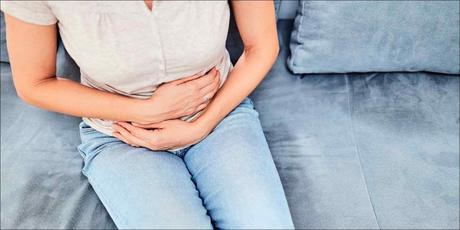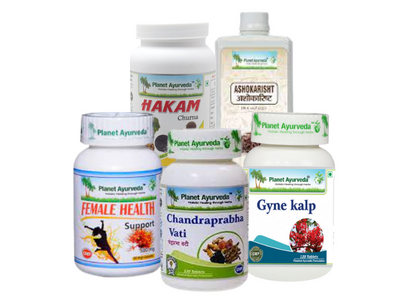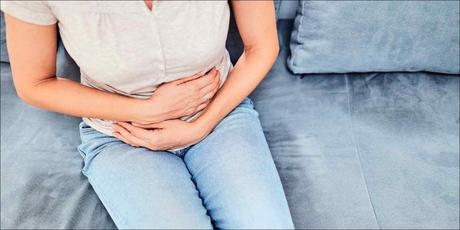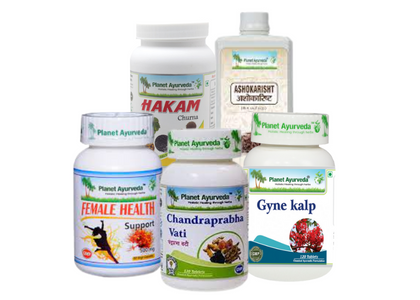Dysmenorrhea is painful menstruation that is caused by uterine contraction. Usually, menstruation is the regular discharge of blood and mucosal tissue which is the innermost lining of the uterus through the vagina. The falling of the progesterone hormone triggers menstruation, the first period is menarche which begins between the age of 12-15 years of age. Symptoms in advance of menstruation that interfere with the average life cycle are known as premenstrual syndrome (PMS). The first day of menstrual bleeding is called LMP (last menstrual period). The average volume of menstrual fluid during a month is 35 milliliters. It is reddish brown in color and slightly darker than venous blood. The blood contains sodium, calcium, vaginal secretion, and endometrial tissue. An enzyme presently known as plasmin which is there is endometrium which inhibits the blood from clotting. The menstrual changes are a series of changes in the hormone, ovarian cycle controls the production and release of eggs and estrogen, and progesterone. The rise and fall of FSH prompt the production and growth of oocytes. These hormones stimulate the lining of the uterus and thicken it to accommodate fertilization. If the implantation does not occur the lining breaks down and blood is released. In this article, we will discuss the causes and symptoms of dysmenorrhea and its ayurvedic aspect.

INTRODUCTION
Dysmenorrhea is a term used for painful menstruation, the pain is usually in the pelvis or lower abdomen. There are two types of dysmenorrhea- Primary and secondary. Primary dysmenorrhea occurs in people who experience pains before menstruation and Secondary menstruation is having normal periods but becomes painful later in life. This is usually affecting the uterus such as endometriosis, and uterine fibroid. Dysmenorrhea can occur without any underlying problem, and symptoms usually last for less than 3 days. Menstrual cramps are throbbing, aching cramps which start in the lower belly and are the most annoying part of the period. The cramps can range from mild to severe, they usually happen for the first time a year but they usually become less painful. Dysmenorrhea includes painful menstruation of sufficient magnitude to incapacitate day-to-day activities. It occurs less often in those who exercise daily and in women who have children early in life.
MYTHS AND FACTS ABOUT DYSMENORRHEA
1. Myth- In some parts of India there are dietary restrictions such as sour food, and tamarind as it is believed that these foods will stop menstruation.
Facts- These foods cause discomfort to the women, hence avoided.
2. Myth- Girls believe exercise or any physical activity during menses aggravates dysmenorrhea.
Facts- exercise releases serotonin which helps to relieve painful menses and bloating
3. Myth- Menstrual cramps are warning signs of infertility.
Facts- Menstrual pain is caused by uterine contraction. It is a natural phenomenon, but it can be a symptom of another health problem that causes infertility.
4. Myth- Dysmenorrhea is associated with PMS (premenstrual syndrome) which is in one's head.
Facts- the cause is unknown but hormones play an important role in this. So one must do regular exercise and healthy eating which reduces the symptoms.
CAUSES OF DYSMENORRHEA
1. Primary Dysmenorrhea
- Pain is due to dysrhythmic contractions of the uterus and uterine hypoxia.
- Pain can be cured following pregnancy and vaginal delivery
- It is caused by the excessive level of prostaglandins hormone. This hormone makes the uterus contract during childbirth and menstruation, it even gets worse when the uterus is tilted backward, during irregular menstrual periods, and being overweight starts before the age of 12 years.
- The primary history of primary dysmenorrhea
- Social stress
- It includes conditions such as fibroid (benign tumor which develops in the uterine wall)
- A sexually transmitted infection
- Endometriosis (tissue lining the uterus is found outside the uterus because the pieces of tissue during the period cause swelling and scarring.
- Ovarian cyst or tumor
- Cervical stenosis (narrowing of the cervix)
SYMPTOMS
The clinical features of primary dysmenorrhea are as follows- Onset shortly after menarche
- Duration is usually 48-72 hours
- Cramping and labor type of pain
- Constant lower abdomen pain that radiates to the low back and thigh
- The pain diminishes as age progresses.
- Usually begins after the 20s
- Heavy menstrual flow
- Poor response to oral contraceptives and NSAIDs.
- Infertility
- Abnormal vaginal discharge
- Dyspareunia (painful sexual intercourse)
DIAGNOSIS
- Ultrasound
- CT Scan
- MRI (magnetic resonance imaging)
- X-Ray
- Laparoscopy
- Hysteroscopy
TREATMENT
- Pain relievers (Ibuprofen, naproxen sodium)
- Hormonal birth control
- Surgery (hysterectomy)
- Abdominal massage
- Endometrial ablation
- Endometrial resection
- Antidepressants
PREVENTION
It can be modified by diet and lifestyle changes
Lifestyle changes
- Exercise regularly
- Low-fat vegetarian diet
- Reduce caffeine intake
- Reduce alcohol intake
AYURVEDIC MANAGEMENT
In Ayurveda dysmenorrhea is termed as Kashta artava which is due to aggravated Vata dosha, Apana Vata a subtype of Vata is responsible for the normal regulation of menstruation gets disturbed due to some causative factors and Vata gets vitiated.
NIRUKTI (derivation)
Kashtena muchyati its kashtaartava
This means in this artava (menstrual bleeding) is shredded with great difficulty and causes pain.
SAMANYA NIDANA (ETIOLOGY)
- Mithiya Sahara (improper diet)
- Mithiya vihara (improper activities)
- Pradushta artava (fault in hormones)
- Bija dosha (genetic factors)
- Daiva (idiopathic)
- Manasika hetu (Vata is vitiated by grief and thinking)
LAKSHANAS (symptoms)
1. Vatika yoni roga - is related to primary dysmenorrhea, due to aggravation of Vata dosha it leads to frothy, thin, and unctuous which is associated with pain and sound.
2. Udavartini Yonivyapad - it is due to the suppression of urges such as flatus, which reverses the aggravated Vata, instead of normal downward movement it moves upward and fills in the uterus, it pushes the blood upwards with pain, it is also related to primary dysmenorrhea.
3. Antarmukhi Yonivyapad - when a woman has a heavy meal and indulges in sexual activity the position of Vata is pressed by the food and causes crookedness of the cervix. It is related to secondary dysmenorrhea.
4. Suchimukhi yonivyapad - It is a congenital disease, related to cervical stenosis and is secondary dysmenorrhea.
5. Mahayoni Yonivyapad - when women indulge in sexual activity in an uneven bed, which aggravates the Vata and affects the uterus. It causes stiffness in the orifice of the uterus and cervix.
6. Artava Kshaya - it is primary dysmenorrhea due to nutritional deficiency, and irregular menstruation.
SAMPRAPTI GHATAKA
1. Dosha- Vata Pradhan tridosha
- Vata- vyana and apana
- Pitta- Ranjaka and pachaka
- Kapha- anubandhita dosha
2. Dhatu- rasa, rakta, artava
3. Updhatu- arrival
4. Agni- jathragni, rasagni, raktagni
5. Srotas- rasa, rakta, aratvavaha srotas
6. Srotodushti- sanga and vimargagamana
7. Rogamarga- ab yantra
8. Vyaktasthana- garbhashaya
UPASHAYA (PACIFYING FACTOR)
- Hot bag fomentation on the lower abdomen
- Intake of warm, unctuous food and drink
- Daily practice of yoga and pranayama
ANUPASHAYA (NON-PACIFYING FACTOR)
- Exposure to cold weather
- Skipping meals
- Excessive stress
- Keeping awake at night
- Daytime sleeping
CHIKITSA SUTRA (LINE OF TREATMENT)
1. Shodhana (purification therapy)- Snehan
- Swedana
- Virechan (purgation)
- Vamana (emesis)
- Basti (enema)
- Sthanika chikitsa- it is done by using Kalka, Pichu (tampoon), yoni prakshalana (douching), abhyanga (massage)
- Abhyantra chikitsa- with the help of Arishtam, graham, choornam, and vati (tablets).
VARIOUS HERBS USEFUL IN DYSMENORRHEA
HERBAL REMEDIES BY PLANET AYURVEDA FOR DYSMENORRHEA
Planet Ayurveda is an ayurvedic manufacturing company that makes its products purely from plant extract, no animal products are used. It has many branches overseas. Planet Ayurveda is a GMP-certified, USA-FDA registered, and ISO 9001:2015 certified ayurvedic company. The whole formulations are made according to ancient ayurvedic texts, and the products are free from any kind of preservatives and additives. The ingredients are pure without any adulterations of any kind. They cause no side effects on one's life and are safe to use. Planet Ayurveda formulated many herbal remedies which are very useful and effective remedies.
Product List
1. Female Health Support
2. Chandraprabha Vati
3. Gyne Kalp
4. Ashokarisht
5. Hakam Churna


Product Description
1. Female Health Support
Female health support is polyherbal capsules that are prepared by planet ayurveda using ingredients such as Ashoka (Saraca indica), Lodhra (Symplocos racemosa), and Shatavari (Asparagus racemosus). These capsules are helpful in controlling vitiated Vata and Pitta doshas. Helps to regulate the female menstrual cycle, useful in leucorrhea, painful menstruation, and in all female problems. Shatavari helps to regulate the hormone imbalance, good in removing weakness in females.
Dosage 1-2 capsules twice daily with plain water after meals.
2. Chandraprabha Vati
Chandraprabha Vati is an herbal tablet which is made by planet ayurveda using ingredients such as Shilajit (Asphaltum), Shankara (Sugar), Karpoor (Cinnamomum camphora), Chavya (Piper chaba), Maricha (Piper nigrum) an d many more. It is helpful in many urinary tract disorders, relieves colds, and urinary calculi, and acts as an anti-aging, used in piles, indigestion, and in bronchitis.
Dosage 1-2 tablets twice daily with lukewarm water
3. Gyne Kalp
Gyne Kalp is a herbal tablet prepared by Planet Ayurveda using ingredients such as Shatavari (Asparagus racemosus), Lodhra (Symplocos racemosa), Ashoka (Saraca asoca). These tablets are useful in maintaining the health of females, balancing the doshas, and helping to keep hormones in the normal range. Gyne Kalp helps to strengthen the female reproductive organs.
Dosage 1-2 tablets twice daily.
4. Ashokarisht
Ashokarisht is a classical herbal formulation that is prepared by planet ayurveda using various ingredients such as Ashoka (Saraca indica), Gur (Saccharum officinarum), Sonth (Zingiber officinale), Amla (Emblica officinalis) and many more. It helps in many disorders such as Piles, female hormonal disturbances, polyuria and in inflammation. Ashokarishta is helpful in leucorrhea and polycystic ovarian syndrome.
Dosage 2 tsp twice daily with an equal amount of water.
5. Hakam Churna
Hakam Churna is a polyherbal choornam that is formulated by planet ayurveda using ingredients such as Chandershoor (Lepidium sativum), Ajwain (Trachyspermum ammi), Methi (Trigonella foenum graecum). It helps to balance tridosha, and innate strength improves liver functions and improves digestion. It has anti-inflammatory properties and discourages the production of Aama.
Dosage 1 teaspoon twice daily with hot water.
CONTACT PLANET AYURVEDA TO PROVIDE YOU WITH THE COSTING / ORDERING AND DELIVERY INFORMATION AT - [email protected] OR CALL AT +91-172-5214040CONCLUSION
Dysmenorrhea is painful menstruation that is caused by uterine contraction. Usually, menstruation is the regular discharge of blood and mucosal tissue which is the innermost lining of the uterus through the vagina. Dysmenorrhea can occur without any underlying problem, and symptoms usually last for less than 3 days. Menstrual cramps are throbbing, aching cramps which start in the lower belly and are the most annoying part of the period. In Ayurveda dysmenorrhea is termed as Kashta arrival which is due to aggravated Vata dosha, Apana Vata a subtype of Vata is responsible for the normal regulation of menstruation gets disturbed due to some causative factors and Vata gets vitiated. Planet Ayurveda provides many herbal remedies which will provide great relief to patients without causing any side effects.
DR. Vikram Chauhan, MD - AYURVEDA is an expert ayurvedic doctor based in Chandigarh, India and doing his practice in Mohali, India. He is spreading the knowledge of Ayurveda - Ancient healing treatment, not only in India but also abroad. He is the CEO and Founder of Planet Ayurveda Products, Planet Ayurveda Clinic and Krishna Herbal Company. Write at - [email protected], Contact at - +91-172-521-4030 Websites - www.planetayurveda.com, www.alwaysayurveda.com
View more posts from this author
- Pain is due to dysrhythmic contractions of the uterus and uterine hypoxia.
- Pain can be cured following pregnancy and vaginal delivery
- It is caused by the excessive level of prostaglandins hormone. This hormone makes the uterus contract during childbirth and menstruation, it even gets worse when the uterus is tilted backward, during irregular menstrual periods, and being overweight starts before the age of 12 years.
- The primary history of primary dysmenorrhea
- Social stress
- It includes conditions such as fibroid (benign tumor which develops in the uterine wall)
- A sexually transmitted infection
- Endometriosis (tissue lining the uterus is found outside the uterus because the pieces of tissue during the period cause swelling and scarring.
- Ovarian cyst or tumor
- Cervical stenosis (narrowing of the cervix)
- Onset shortly after menarche
- Duration is usually 48-72 hours
- Cramping and labor type of pain
- Constant lower abdomen pain that radiates to the low back and thigh
- The pain diminishes as age progresses.
- Usually begins after the 20s
- Heavy menstrual flow
- Poor response to oral contraceptives and NSAIDs.
- Infertility
- Abnormal vaginal discharge
- Dyspareunia (painful sexual intercourse)
Lifestyle changes
1. Dosha- Vata Pradhan tridosha
- Vata- vyana and apana
- Pitta- Ranjaka and pachaka
- Kapha- anubandhita dosha
2. Dhatu- rasa, rakta, artava
3. Updhatu- arrival
4. Agni- jathragni, rasagni, raktagni
7. Rogamarga- ab yantra
8. Vyaktasthana- garbhashaya
- Hot bag fomentation on the lower abdomen
- Intake of warm, unctuous food and drink
- Daily practice of yoga and pranayama
- Sthanika chikitsa- it is done by using Kalka, Pichu (tampoon), yoni prakshalana (douching), abhyanga (massage)
- Abhyantra chikitsa- with the help of Arishtam, graham, choornam, and vati (tablets).
1. Female Health Support
2. Chandraprabha Vati
4. Ashokarisht
5. Hakam Churna


Dosage 1-2 tablets twice daily.

